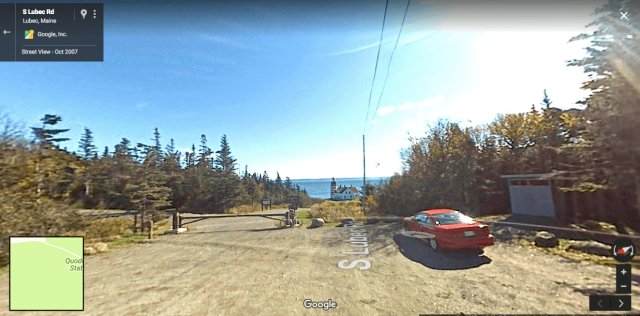Credit: Google

Matthew Muspratt lives in Africa, working as “an American lawyer tending to microfinance and legal aid projects in humid Ghanaian cities and lush Sierra Leonean villages.”
In the Boston Globe he writes of his desire to become better acquainted with another mysterious continent – his own:
“Coastal, global, and utterly educated, I frequently encounter an America I do not know well — the America that has sent people like me to read ‘Hillbilly Elegy,’ ‘White Trash,’ and ‘Strangers in Their Own Land’ in search of understanding.”
Of course, books are no substitute for direct experience – and what better way to experience America’s ‘flyover country’ than a road trip? However, being based abroad, Muspratt turned to Google Street View.
If you’ve never used it, Street View is a wonder of the modern age – a vast database of panoramic images captured by vehicle-mounted cameras moving along millions of miles of road. Arrows within each image let you click forwards and backwards to the next or the previous image (or left and/or right at road junctions). You can carry on clicking ad infinitum, ‘travelling’ any distance you choose.
Most users just want to check out a short stretch of road or a single building, but Muspratt had a more ambitious itinerary:
“I started at the easternmost point on the US mainland – West Quoddy Head, Maine – and clicked westward once, and then again and again. Petabytes of Google imagery later, I found myself halfway across the country with a journal full of small-town historical anecdotes and screenshots of the open road. It is the Great American Road Trip, done virtually.”
This certainly requires patience, but compared to a highly edited travelogue or news report, Street View gives you an unposed, unspun view of the places you’re seeing:
“I’d been streaming America in the uncompromising volumes and divisive tones of 24-hour news cycles and now-now-now social media. I needed doses of the America I hoped still existed, of less angst, more commonality.”
So, travelling click-by-click, what does the great American road trip reveal?
“America is deeper than Twitter and Facebook feeds would suggest; America is, yes, great.
“Still, it is impossible to miss something else in Street View America: vacant and derelict buildings are endemic; inequality runs visibly rampant. From rural Maine to the Rust Belt’s heartland and west, I cannot click but minutes without encountering an abandoned home or gutted Main Street. An hour in West Virginia and central Ohio downloads enough barren steel industry apparatus and one-bar, one-post-office town centers that the disconnect from wealth – and Washington – is palpable.”
The cultural elites tend to live in global cities where the world is laid out before them; different languages, cultures, cuisines can be sampled – or not – without effort or commitment. When the elites do leave their cities it is to rural or suburban retreats where only some of the people and places they have to share a country with are on view – i.e. their sort of people; their sort of places.
Tools like Google Street View give us all a chance to break out of our bubbles. To see the nations we belong to as they really are. The view is a distant one, but unlike almost any other medium it is unfiltered and undiluted:
“Street View travel is my awakening. It is one thing to read narratives and case studies of our national fracture. It is another to actually see it, face-to-screen, by scrolling slowly through one disenfranchised town after another in a sequence so sure that the breadth and depth of the Trump-American landscape feels as infinite as Google itself.”
Book your trip now.










Join the discussion
Join like minded readers that support our journalism by becoming a paid subscriber
To join the discussion in the comments, become a paid subscriber.
Join like minded readers that support our journalism, read unlimited articles and enjoy other subscriber-only benefits.
Subscribe